

![]()
INTRODUCTION TO THE 18TH & 19TH CENTURIES
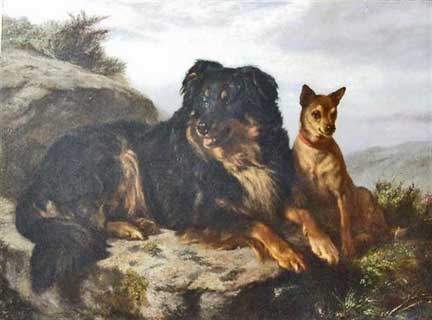
Above, a black-and-tan collie resting with another dog,
probably some kind of terrier (a Manchester, perhaps).
Oil on canvas by Samuel John Carter (1835-1892),
a Royal Academy exhibitor and English sporting and canine artist.
This color is unusual in Border Collies today, but can be found in the English Shepherd,
and was a very common collie color in the 18th and 19th centuries.
(Many thanks to John Hamshere of the Hamshere Gallery in London
for sending us this picture. Hamshere Gallery specializes in 19th century dog paintings.)
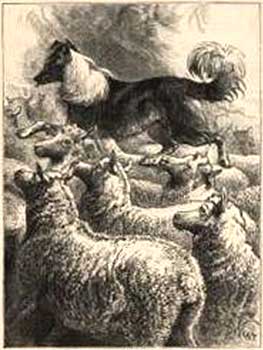
Left, a 19th century engraving
of a working sheepdog going
over the backs of the sheep by Harrison Weir.
The 18th and 19th centuries are the richest feeding ground for those interested in the history of the shepherd's dog. For one thing, taxonomy, the science of classification, flourished; and for another, naturalism, the observation of nature to gain knowledge, thrived and caught on among ordinary people. There was a genuine hunger for knowledge and a striving to satisfy that hunger. We have many notable examples of the shepherd's dog in literature and art on this website, but, as we don't have room for full pages on every artist or author, or on every work, some will only be mentioned here, others might have a paragraph or more devoted to them on this page if it's warranted. Those that appear in links do have their own web pages on this site.
Below, a sheepdog with his flock,
a gorgeous 19th century illustration,
artist unknown. (Thanks to Niki Sawyer.)
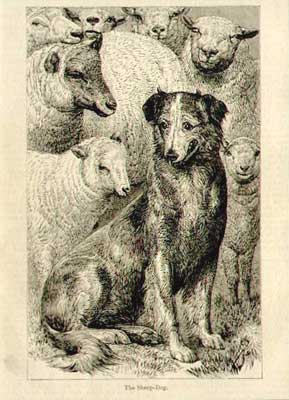
One of the earliest poets of the 18th Century to mention the shepherd's dog was John Gay (1688-1732). Gay's Fables (1727) was later published in an edition illustrated by Bewick, and later still in the collection, The Poetical Works of John Gay (1854), with a "Life of Gay" written by Samuel Johnson.
Gay was descended from an old family in Devonshire. His early education gave him a taste for poetry, but he was apprenticed to a silk mercer. He soon wearied of that occupation and, as Johnson says, "easily persuaded his master to discharge him." He was taken into service as a secretary to the Duchess of Monmouth and in his spare time he began to write poetry. He subsequently became friends with Alexander Pope (1688-1744), who is generally regarded as the greatest English poet of the eighteenth century (Wikipedia), a friendship that was to last until his death.
In 1714 Gay published The Shepherd's Week, six English pastorals. Johnson is critical of them and they have not so much as a nod toward the shepherd's dog. Gay is best known as the author of The Beggar's Opera (1728) and Johnson believes that Gay's introduction of the ballad opera, a form of comedy, is what makes him memorable. Johnson was not impressed with Gay as a poet. The Poetical Works is a collection of all of Gay's poetry, including "The Shepherd's Week" and "The Fables."
Gay's Fables, which is what interests us most, were favorably received in Gay's own day, and so popular that Gilbert Grey, in his Complete Fabulist: Or A Choice Collection of Moral and Entertaining Fables, In Prose and Verse, From the Best Author's Ancient and Modern (1732), included Gay's fables in their entirety in his own book. While he does not credit the authors in the first section of his book, "Fables from various Authors," the "Fables by Mr. Gay" have a section all their own.
In the long fable, "The Man, the Cat, the Dog, and the Fly," a poem on the merits of various providers of services to Britain (like traders, the navy, the weaver, the farmer, etc.) the man asks several animals what use they are, and the shepherd's dog answers:
My vigilance and trusty zeal
Perhaps might serve the public weal.
Might not your flocks in safety feed,
Were I to guard the fleecy breed?
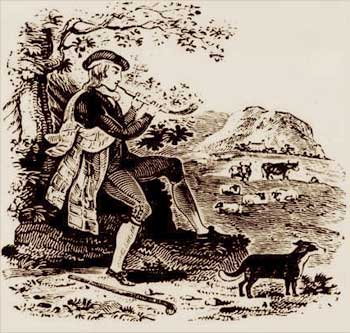
Left, an 18th century illustration of a shepherd, artist unknown. The shepherd is playing on a curved pipe or horn. With him is his dog, which seems almost like an afterthought, it is so relatively small. In the background are his charges, sheep and cattle. The shepherd has a stick as well (on the ground near his right foot, but it's more like a walking stick, with a knob on the top instead of a crook.
The man agrees that these are worthy services.
In "The Shepherd's Dog and the Wolf," a philosophical discussion between Lightfoot (the dog) and the wolf, the two effect a truce in order for the dog to understand why the wolf preys on his "harmless...fleecy care" (sheep). The wolf points out that although hunger drives him to eat the occasional sheep, "ten thousands are devour'd by men."
In most of Gay's fables, however, the shepherd's dog does not come off as a sympathetic character, at least not to modern ears. Gay always casts the shepherd's dog on the moral high ground, but he comes off as being complacent. In "The Cur, Horse, and Shepherd's Dog", the cur (in this case similar perhaps to a Jack Russell Terrier) barks and chases a horse and gets badly kicked for his pleasure. The shepherd's dog basically says "I told you so!". Gay meant it as a platitude, but to us he sounds smug and self-satisfied. In the "The Dog and the Fox," the shepherd's dog, if I might bend the allusion slightly, beards the fox in his own den by engaging him in conversation and tricking him. Lulled by the sweet-talking dog, the fox admits that he stole three lambs and gets killed for his naiveté.
We may not like this shepherd's dog, but the fact that he is mentioned at all is proof enough of his existence.
Perhaps the earliest training manual for sheepdogs was written by William Ellis (ca. 1690-1759). Ellis was a farmer from Little Gaddesden in Hertfordshire, about 30 miles northwest of London. In 1732 he wrote The Practical Farmer or The Hertfordshire Husbandman. His book enjoyed popularity immediately upon publication, but, says George Edwin Fussell in his book, More Old English Farming Books from Tull to the Board of Agriculture, 1731 to 1793 (1950, C. Lockwood):
Below, "The Shepherd's Dog"
Chambers's Encyclopaedia, 1883.
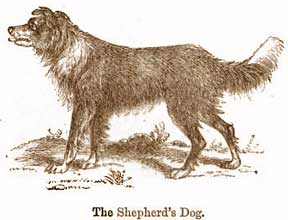
Inevitably, he neglected the running of his farm. The disappointment of the eager visitors who came to see marvels and found at the best "plain farming", at the worst dilapidation, was marked by a fall in the sales of his books. It was doubtless considered presumptuous in a man who made no better a practical show than themselves to write so learnedly of what ought to be done by a scientific farmer. All his enthusiasm for new methods of manuring or of sheep management, and for the novel crops like turnips and lucerne, was impertinence to his public when not combined with their practice and cultivation on his own acres.
In Book I, Ellis has two chapters on shepherd's dogs. Chapter I is called "Of Shepherd's and their Dogs. In it he describes how valuable a "well-qualified Dog" is to the shepherd, and how the dog works:
...This Dog was so well broke that he would go before a Flock, round it, side it, or keep behind it, and this nearer or father off, at the Word of Command...that he would keep them from straying too far about; and when they were to be driven to the Fold, he would fetch the Stragglers together from near a Mile Distance, and then drive them fast or leisurely as commanded. If leisurely, he would keep behind them and not bark; if fast, he would bark...Then when they came to the Gate of the Field, they were to be folded in, he would go before and stop them there till they were let in.
In Chapter II "Of Breaking or Learning Dogs [and] How to Make Them Serviceable Attendants on Shepherds" Ellis' description of the dog sounds very like the rough-coated English Downland sheepdogs that eventually evolved into the Old English Sheepdog and other "bearded" dogs:
A Shepherd generally keeps a rough-coated Dog, partly, I suppose, for their being, as I said, better enabled by their fluffy warm Coat, to withstand the Violence of Frosts and cold Winds, or to become the more frightful to their Sheep, and for his closer Attendance on his Master, as he is somewhat slower than a smooth-coated one, therefore not so subject to hare and run the Sheep too fast; and is commonly the most sensible one of all others...One Thomas...has a has a brindle-colour'd, very shaggy-hair'd Dog, of the biggest Sort, so much at Command, as to lie down by a Fold all Night to guard the Sheep till next Morning; and for making haste on an emergent Occasion, when Sheep are pent in a narrow Place, will run over their Backs; and in several other Respects, makes himself an excellent Shepherd's Dog...
Below, "Shepherd's Dog"
from another edition of
Chambers's Encyclopaedia".
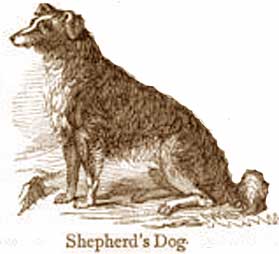
But he also admits that "others keep a smooth-coated Dog" and says:
But let him be of any Sort, he should be rather long than thick-sided, that he may better perform his Pursuit with greater Velocity; and strong withal, the better to deal with the Enemies of the Sheep, and defend his Master upon Occasion, against any Adversary...Yet a proper Degree of Courage is absolutely necessary in a Dog, and so is a good Size, that he may be willing and able to seize and hold the stoutest Ram, prevent the Flock from hurt by other Dogs; and, as I said defend his Master..
The proper age to begin training, Ellis says, is 6 months old, but at 9 months old if the dog is not well grown at six months. He considers proper feeding to be important and tells his readers not only what to feed, but where to obtain it. "Pollard," he says, which is the wheat left over after grinding and the bran removed or a mixture of fine bran and a small amount of flour, "is sold at most Country Grocers or Chandlers Shops."
Ellis goes on to explain that "The first Motion or Trick, is to [teach the dog to] lie down at the Word or Command." His methods are quite modern, using encouragement before force, and even food rewards before corrections. He teaches "stand still," "bark on command," "go round the flock," and "side a Flock of Sheep". By this I believe he means what in other breeds of herding dogs are referred to as "tending" behavior, or patrolling the sides of the flock to keep them in order and out of fields. And finally, Ellis explains "taking a Sheep by the Ear" (to hold it for the shepherd or throw it to the ground). He emphasizes that it is fruitless to try to teach a shepherd's dog by beating it. These are very enlightened ideas and may surprise you given the era, when in some circles children may not have been treated as well. Ellis does digress into anecdotes about poor training, cruel practices of the day, and so on. The rest of the book is devoted to sheep raising and veterinary matters.
Myriad natural histories were written in the 18th and 19th centuries. The Comte de Buffon's Natural History in 36 volumes was written between 1749 and 1788. In 1790, Thomas Bewick's History of Quadrupeds was published. Around 1800 Sydenham Edwards' Cynographica Britannica, an encyclopedia of British dog breeds, was published. The Rev. W. Bingley's Memoirs of British Quadrupeds came out in 1809. William Youatt wrote The Dog in 1845.
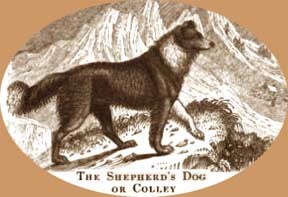 Right, the following three illustrations are James Hamilton Fennell's Natural History of British and Foreign Quadrupeds (Joseph Thomas, London, 1841).
Right, the following three illustrations are James Hamilton Fennell's Natural History of British and Foreign Quadrupeds (Joseph Thomas, London, 1841).
One natural history that seems a cut above the rest is A Natural History of British and Foreign Quadrupeds, Containing Many Modern Discoveries, Original Observations, and Numerous Anecdotes (1841) by James Hamilton Fennell. In the 18th and 19th centuries, it was common to give non-fiction books long, descriptive titles. Fennell's Natural History may have been as derivative as most others were, but not so obviously so, and he expresses disdain for Buffon in his preface, and for good reason. Buffon came up with (dare I say harebrained?) theories that could not be substantiated scientifically, and lesser writers than Fennell happily repeated them. Fennell also has a longer chapter devoted to the shepherd's dog than other natural histories of the day, including some descriptive anecdotes that unfortunately we don't have room for here. About the "Shepherd's Dog or Colley," Fennell wrote:
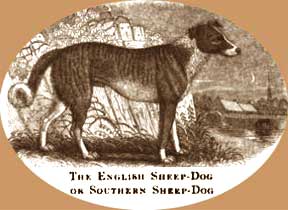
He is of all dogs the most intelligent and faithful, and at the same time the most useful. In the wild and mountainous parts of Scotland and Wales...we shall find him left in care of hundreds of sheep, and displaying the greatest activity, vigilance, and courage in minding his charge.
Some of these dogs possess the faculty of discovering by the smell any sheep which may have had the misfortune to be overblown by the snow, in which scores of them are frequently buried to a depth of several feet in a very few hours after the snow has commenced. When the dog is used for this purpose he is called a sheep-setter, or sheep-finder.
The duties of the sheep-dog, when attending a flock on the road, demand his constant watchfulness and exertion. One minute he is barking with all his might to urge on the main body--now he is bounding forward to restrain stragglers--now circling the flock,--and now again returning to his master's side, to receive his look of approbation or his further commands.
A good sheep-dog possesses the sense of sight so perfectly, that he can readily discover a strange sheep among a very large flock under his care. When there is an intruder among the flock, the drover has only to give the word to his dog, and the sagacious animal dashes forward over the several fleecy backs, singles out the runaway without the least hesitation, and seizing him by the loose skin of the neck, bears him to the ground, and holds him fast until assistance arrives.
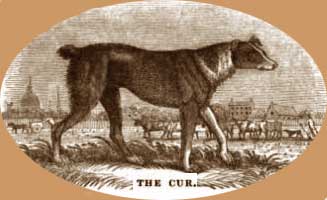
Fennell, like Bewick, divides shepherd's dogs into three categories or types: the Shepherd's Dog or Colley; the English Sheep-Dog or Southern Sheep-Dog; and the Cur or Drover's Dog. "The English sheep-dog," he says, "is larger and less shaggy than the colley." Of the English or Southern sheep-dog, Fennel wrote:
This breed seems to have originated in a cross of the colley with the mastiff. While the former is the Scottish and Welsh sheep-dog, the present animal is the original or true English one, although the colley is now in general use on the extensive downs of Wiltshire, and in some other parts of this country."
While it appears that Fennell must be describing the Old English Sheepdog here or one of the similar types used on the English Downs, his illustrations belie this assumption, and he appears to be actually speaking of a smooth-collie-type. Separating the shepherd's dog into three distinct breeds and assuming crosses with other breeds only tends to confuse things.
Elzear Blaze's History of the Dog in 8 volumes, published in Paris in 1843, made this interesting observation:
When...manifest superiority is combined with good nature, the dog will sometimes take only a playful vengeance. Colonel Hamilton Smith witnessed a curious scene between a cur and a shepherd's dog, in which the former had bitten a sheep, and the latter to punish him dragged him by his ear to a puddle, where he kept dabbling him in the mud.
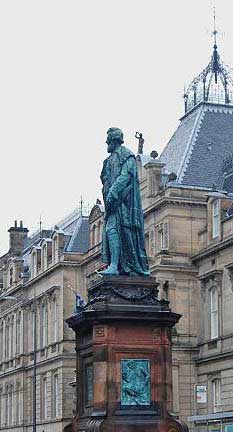 Left, a photo of the statue of William Chambers in Edinburgh's Chambers Street. (This work is licensed under the Creative Commons Attribution 3.0 License. Some rights reserved.)
Left, a photo of the statue of William Chambers in Edinburgh's Chambers Street. (This work is licensed under the Creative Commons Attribution 3.0 License. Some rights reserved.)
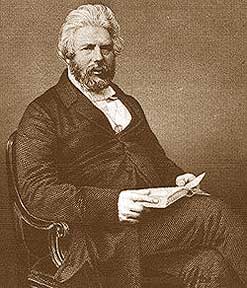 Right, a photo of Robert Chambers (in the Public Domain).
Right, a photo of Robert Chambers (in the Public Domain).
As well as natural histories, encyclopedias also flourished during this period. We have seen pictures of the shepherd's dog from various editions of Chambers's Encyclopaedia. Chambers's Encyclopaedia (1859-1868), published by William and Robert Chambers, brought many topics, including the shepherd's dog, to ordinary people who would probably otherwise never have seen a sheepdog: people who lived in urban environments. It was edited partly by the publishers, but also by other editors, and it was edited, revised, and re-issued in numerous succeeding editions throughout the second half of the 19th century and into the 20th century.
William (1800-1883) and Robert (1802-1871) Chambers were born in Peebles in the Scottish Borders. Both boys were born with six fingers on each hand and six toes on each foot. Their parents sought to correct this abnormality with surgery. William's surgery was a success, but Robert was left partially lame, which made him turn to books. That is not to say he would not have otherwise become learned, however, as both brothers became publishers and politicians, and were influential in mid-19th century science and politics.
Of shepherd's dog, the Encyclopaedia has this to say:
The Shepherd's Dog is covered with long, flowing, and somewhat woolly hair; his muzzle is long and pointed, and his ears erect, and slightly bent downwards at the tips; his tail is long and bushy; and the usual colour of his fur is black and white, or varied with black and gray; the backs of his fore-legs have also long hairs.
Remember, the Chambers brothers were Scottish and lived in the Borders or Edinburgh. They are describing a collie, likely of the Border Collie type. They report the dog is usually black and white, but they also seem to be indicating that sometimes there are blue merles. They go on to say:
The peculiar and highly useful qualities of this dog seem to be rather intuituve than acquired; indeed, scarcely anything can exceed the quickness with which he is taught; and certainly no other dog has the same patient perseverance and courageous fidelity, or greater discrimination. The labour of a shepherd, with the assistance of this faithful and intelligent animal, is comparatively an easy task; and it is hardly possible to fancy a more arduous employment than it would be without it; for without him, how could he collect extensive flocks scattered over high and widely spread mountain-ranges?
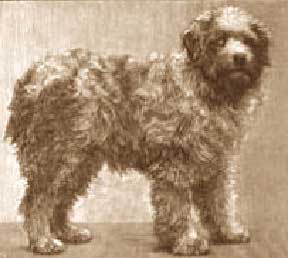 Left, "Wall-eyed Bob" from Chambers's Encyclopaedia.
Left, "Wall-eyed Bob" from Chambers's Encyclopaedia.
So, the editors recognize herding instinct, and are familiar with Hogg and paraphrase him. The articles on the shepherd's dog in many editions of the Encyclopaedia are long, and cover such topics as how sheepdogs work; guardian breeds, drovers dogs and curs and how they differ from the shepherd's dog; and sheepdog types in other countries. In at least one edition there is discussion of "another variety of the sheep-dog...the Bob-tailed or Moorland Collie" and there is a photo of "Wall-eyed Bob" as illustration. "Wall-eyed" refers to the fact that Bob has blue eyes, or possibly one blue eye and one brown eye; and he is clearly of the "bearded" type possibly from the English Downs.
William and Robert Chambers published numerous other encyclopedic books, some of which also have at least paragraphs on the shepherd's dog. Their Chambers's Information for the People, Volume I (1884), for example, under the heading "Sheep" gives this sage advice:
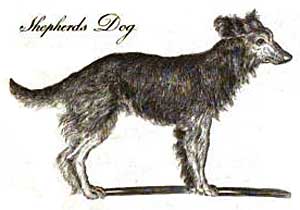 Right, a shepherd's dog from the Encyclopaedia Britannica, 1797.
Right, a shepherd's dog from the Encyclopaedia Britannica, 1797.
The tendency which most sheep have to ramble, renders it necessary for them to be attended by a shepherd and his dog. The duties of a shepherd are irksome, and require to be performed by a man of firm resolution, good temper, and discretion. To keep the flock within bounds may be troublesome, but much may be done in the way of prevention; and, at all events, the sheep must not be harassed and chased as if they were so many wild beasts. Being naturally of a timid and gentle nature, the sheep ought to be treated with gentleness. Lazy shepherds who do not exercise a judicious foresight in keeping the flock to its ground, try to remedy the evil by hounding or driving the dog after the stragglers, besides giving no small toll to their own limbs in running. We are desirous to lay it down as a rule, which however, is well known to all good shepherds, that there should be only a rare and cautious use of the dog. Much also depends on the dog being of the proper breed, and well trained to his duty. A good dog gives little tongue; he is seldom heard to bark; his great knack consists in getting speedily and quietly round the further extremity of the flock, and then driving them slowly before him in the direction which his master has pointed out...Under-bred dogs bark at and fly upon the poor animals chasing them hither and thither without purpose. All such dogs should be destroyed. A first-rate shepherd's dog is invaluable to the store-farmer, and no reasonable price should be grudged to obtain one.
In 1866, George R. Jesse wrote a book with the very ambitious title of Researches into the History of the British Dog from Ancient Laws, Charters, and Historical Records with Original Anecdotes and Illustrations of the Nature and Attributes of the Dog from the Poets and Prose Writers of Ancient, Mediaeval and Modern Times. Jesse was an avid early animal welfare advocate and anti-vivisectionist. He wrote many books and articles championing the rights of "lower animals" including "Legislation for Songbirds" and "Worming for Canine Rabies" (he was vigorously opposed to muzzling dogs for rabies), and Researches into the History of the British Dog was hailed as "...the first comprehensive book on the history of the individual breeds of dog". It was not, however, a breed book as such, as Jesse used literature to illustrate history. The shepherd's dog is represented by a poem by John Wolcott (a.k.a., Peter Pindar, 1738-1819), called "The Old Shepherd's Dog" and by quoting Bewick. Katharaine M. Rogers points out that:
The nineteenth-century public had an insatiable appetite for anecdotes illustrating the moral and intellectual virtues of dogs. George R. Jesse filled the pages of his scholarly Researches...with anecdotes illustrating its faithfulness, sagacity, love, vigilance, and compassion. (First Friend: A History of Dogs and Humans by Katharaine M. Rogers, 2005, Macmillan.)
As the Honorary Secretary of the Society for the Total Abolition and Utter Suppression of Vivisection, Jesse was part of a committee (which included Charles Darwin) that convinced the British Government to put forth a bill to regulate the performance of painful experiments on animals, which became law in 1876.
Below, the following three pictures illustrate three different versions of "The Shepherd's Dog and the Lost Child.
The first one is by illustrator, Harrison Weir. The artists are unknown for the other two,
but in all three illustrations, the dog is clearly a collie of the Border Collie-type.
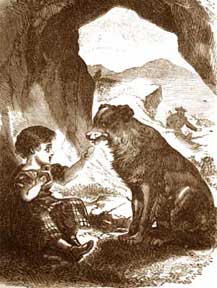
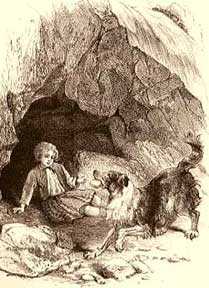
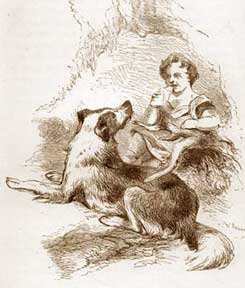
Around the same time that George R. Jesse was writing, another Jesse, Edward Jesse, also produced a book, Gleanings in Natural History (ca 1876). In it he talks about the sagacity of the shepherd's dog, and to illustrate it, he tells a story, in both prose and poetry, about a shepherd's dog that saved a child's life by bringing him food every day. This story, however, appeared to be "going around" at that time, for a number of other authors presented it. In his book, Stories of Animal Sagacity (T. Nelson and Sons, 1875, illustrated by Harrison Weir), William Henry Giles Kingston (1814-1880), an English novelist, also tells this story, and tells it better than most:
This type of story was very popular in the Victorian Era, and there are numerous others. For example, in her book, A Book of Golden Deeds of All Times and All Lands, Charlotte Mary Younge, writing in 1890, tells the story of the shepherd's dog and the lost child, and also another about a collie dog who saved two children lost in the snow.The Shepherd's Dog and the Lost Child
[A shepherd], who had charge of a flock which fed among the Grampian Hills, set out from home one day accompanied by his little boy, scarcely more than four years old. The children of Scottish shepherds begin learning their future duties at an early age. The day, bright at first, passed on, when a thick mist began to rise, shrouding the surrounding country. The shepherd, seeing this, hurried onward to collect his scattered flock, calling his dog to his assistance, and leaving his little boy at a spot where he believed that he should easily find him again. The fog grew thicker and thicker; and so far had the flock rambled, that some time passed before they could be collected together.
On his return to look for his child, the darkness had increased so much that he could not discover him. The anxious father wandered on, calling on his child—but no answer came; his dog, too, had disappeared. He had himself lost his way. At length the moon rose, when he discovered that he was not far from his own cottage. He hastened towards it, hoping that the child had reached it before him; but the little boy had not appeared, nor had the dog been seen. The agony of the parents can be better imagined than described. No torches were to be procured, and the shepherd had to wait till daylight ere he could set out with a companion or two to assist him in his search. All day he searched in vain. On his return, sick at heart, at nightfall, he heard that his dog had appeared during the day, received his accustomed meal of a bannock, and then scampered off at full speed across the moor, being out of sight before any one could follow him.
All night long the father waited, expecting the dog to return; but the animal not appearing, he again, as soon as it was daylight, set off on his search. During his absence, the dog hurried up to the cottage, as on the previous day, and went off again immediately he had received his bannock.
At last, after this had occurred on two more successive days, the shepherd resolved to remain at home till his dog should appear, and then to follow him.
The sagacious animal appearing as before, at once understood his master's purpose, and instead of scampering off at full speed, kept in sight as he led the way across the moor. It was then seen that he held in his mouth the larger portion of the cake which had been given him. The dog conducted the shepherd to a cataract which fell roaring and foaming amid rocks into a ravine far down below. Descending an almost perpendicular cliff, the dog entered a cavern, close in front of which the seething torrent passed. The shepherd with great difficulty made his way to it, when, as he reached the entrance, he saw his child, unhurt, seated on the ground eating the cake brought by the dog, who stood watching his young charge thus occupied, with a proud consciousness of the important duty he had undertaken.
The father, embracing his child, carried him up the steep ascent, down which it appeared he had scrambled in the dark, happily reaching the cave. This he had been afraid to quit on account of the torrent; and here the dog by his scent had traced him, remaining with him night and day, till, conscious that food was as necessary for the child as for himself, he had gone home to procure him some of his own allowance.
Thus the faithful animal had, by a wonderful exercise of his reasoning power, preserved the childs life.
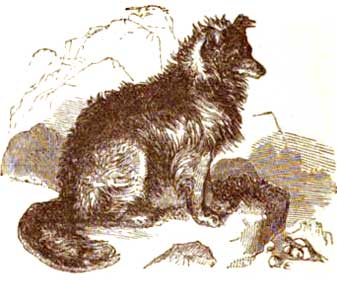 Left, "The Shepherd's Dog", an illustration from the Manual of British Rural Sports by Stonehenge, a wood engraving by "Messrs. Dalziel and Hodgkin from drawings by Wells, Harvey, and Hind."
Left, "The Shepherd's Dog", an illustration from the Manual of British Rural Sports by Stonehenge, a wood engraving by "Messrs. Dalziel and Hodgkin from drawings by Wells, Harvey, and Hind."
John Henry Walsh (1810-1888), a sports writer and editor of The Field, who used the pseudonym of "Stonehenge", wrote Dogs of the British Isles in 1867, which included a chapter on Sheep and Drovers' Dogs. His Manual of British Rural Sports (1859, Routledge, Warnes, & Routledge, London) also had a section on the Shepherd's and Drover's Dogs. He obviously had a very poor opinion of them, for they weren't sporting dogs, after all, and he seemed to feel that they and their equally disreputable owners were poaching game that rightfully belonged to the sportsman:
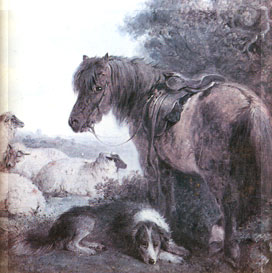 Right, "Waiting for Master" by Edward Robert Smythe (1810-1899).
Right, "Waiting for Master" by Edward Robert Smythe (1810-1899).
The Shepherd's and Drover's dogs are very closely allied, and though not used by the sportsman, yet they are often vexatiously in the way, being employed by poachers to an extent which is scarcely to be wondered at when we consider in whose hands they are constantly kept. These dogs are wonderfully sagacious, and though they have a fine and sharp muzzle, yet they can rival most spaniels in their power of working-out a delicate scent...Their power of endurance is also wonderful, and they will guard a flock of sheep by constantly galloping round them for many hours together. Many singular tales are told of their recovering lost lambs or sheep, or even whole flocks, when they have been overtaken by snow storms; but it is as game-poachers that they here come under consideration. [!]
The most useful and sagacious of all is the Scotch colly, well represented in the ...engraving. He is more hairy, and with a sharper and more fox-like nose than the English sheep-dog or than the drover's dog...It is, however, now generally admitted that the Scotch dog bears the palm in all respects; but still alloyed by a provoking tendency to poach, both in destroying eggs and young leverets, and in afterwards helping to seize game of all kinds and ages.
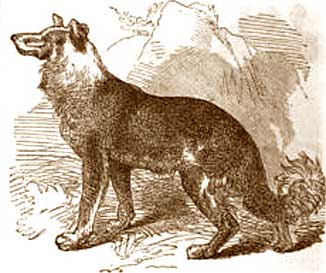 Right, "Shepherd's Dog" from the American Cyclopaedia, artist unknown.
Right, "Shepherd's Dog" from the American Cyclopaedia, artist unknown.
America was not neglected by natural history authors of the period. In 1848 the American Agriculturist (Vol. VII, No. III, March 1848) published an article on The Shepherd's Dog. The American Cyclopaedia: A Popular Dictionary of General Knowledge, edited by George Ripley and Charles A. Dana (Vol. VI, D. Appleton & Co., London and NY) came out in 1874. Of the shepherd's dog it said:
At the head of the list of the domestic canines of temperate Europe stands the shepherd's dog...its appearance is rather unpromising; its shaggy hair is generally varied black and gray, the ears are short and erect, and the tail is bushy and curved; having been trained from time immemorial to the care of flocks, its peculiar faculties seem to be instinctive, and its sagacity, fidelity, and courage are not excelled by any species of dog; the height is not quite 2 ft., but the form is very muscular. This breed is confined to temperate and southern Europe. The true shepherd's dog attends the flocks, keeps them together, and protects them from violence. A variety called the drover's dog, somewhat larger and more rugged, is of great assistance in driving sheep and cattle to market.
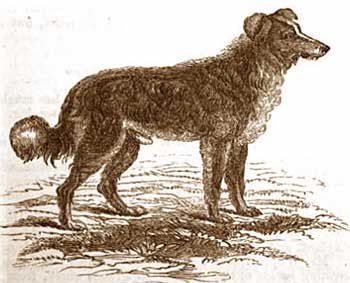 The Shepherd's Dog from Dogs, Their Origin and Varieties by H. D. Richardson, James McGlashan (publisher), Dublin, 1847.
The Shepherd's Dog from Dogs, Their Origin and Varieties by H. D. Richardson, James McGlashan (publisher), Dublin, 1847.
Another American-published work, Glimpses of the Animate World, Or, Science and Literature of Natural History for School and Home, compiled and arranged by James Johonnoot (Appleton & Co., New York, 1888) had a chapter called "Our Canine Servants" which noted "The shepherd's dog will not desert his charge even to get food to save him from starvation." Most of the later natural histories, no matter where they were published, were fairly derivative of earlier works like Buffon and Bewick. All were liberally illustrated, the earlier ones with engravings, the later ones with photographs, and the illustrations seem eerily similar as well.
There are a few works of poetry or narrative prose from that very fertile period that refer to the shepherd's dog, most notably from Robert Burns and James Hogg; and from literary giants like Wordsworth (1770-1850), Thackery (1811-1863), and Hardy (1840-1928). In Far From the Madding Crowd (1874), Hardy's protagonist, Gabriel Oak, looses his entire flock, and consequently his livelihood. For Oak, being a simple shepherd with nothing to his name, such a loss is a tragedy:
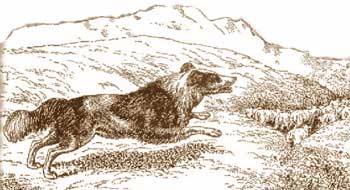 Right, "the shepherd's dog" by English artist Samuel Howitt (1765-1822), is an illustrations for Memoirs of British Quadrupeds by the Rev. W. Bingley (1809).
Right, "the shepherd's dog" by English artist Samuel Howitt (1765-1822), is an illustrations for Memoirs of British Quadrupeds by the Rev. W. Bingley (1809).
Gabriel had two dogs. George, the elder...had originally belonged to a shepherd of inferior morals and dreadful temper, and the result was that George knew the exact degrees of condemnation signified by cursing and swearing...Long experience had so precisely taught the animal the difference between such exclamations as "Come in!" and "D____ ye, come in!" that he knew to a hair's breadth the rate of trotting back from the ewes' tails that each call involved, if a staggerer with the sheep-crook was to be escaped. Though old, he was clever and trustworthy still.
The young dog, George's son, might possibly have been the image of his mother, for there was not much resemblance between him and George. He was learning the sheep-keeping business, so as to follow on at the flock when the other should die, but had got no further than the rudiments as yet--still finding an insuperable difficulty in distinguishing between doing a thing well enough and doing it too well. So earnest and yet so wrong-headed was this young dog...that if sent behind the flock to help them on...he would have chased them across the whole country with the greatest pleasure if not called off...
. . . One night, when Farmer Oak had returned to his house, believing there would be no further necessity for his attendance on the down, he called as usual to the dogs...Only one responded--old George; the other could not be found...Just before dawn [Oak] was assisted in waking by the abnormal reverberation of...the sheepbell[s]...The experienced ear of Oak knew the sound he now heard to be caused by the running of the flock with great velocity.
. . . On the extreme summit...he saw the younger dog standing against the sky...A horrible conviction darted through Oak. With a sensation of bodily faintness he advanced: at one point the rails were broken through, and there he saw the footprints of his ewes...Oak looked over the precipice. The ewes lay dead and dying at its foot--a heap of two hundred carcasses, representing in their condition just now at least two hundred more.
As far as could be learnt it appeared that the poor young dog, still under the impression that he was kept for running after the sheep...had...collected all the ewes into a corner, driven the timid creatures through the hedge, across the upper field, and by main force of worrying had given them momentum enough to break down a portion of the rotten railing, and so hurled them over the edge
George's son had done his work so thoroughly that he was considered too good a workman to live, and was, in fact, taken and tragically shot.
The first half of the 20th century found writers still being influenced by taxonomy and naturalism when W.H. Hudson wrote A Shepherd's Life: Impressions of the South Wiltshire Down in 1910, Adelaide Gossett published her Shepherds of Britain in 1911, and Shepherds of Sussex by Barclay Wills was published in 1938; so these writers must also be included here as well.
At the same time that naturism was flourishing in literature, genre art (art that depicts scenes or events from everyday life) was also growing in popularity, and it is through artists and illustrators like David Wilkie, Edwin landseer, Richard Ansdell, Myles Birket Foster, Albrecht Schenck, Harrison Weir, Edwin Douglas, Heywood Hardy, Joseph Farquharson, and Beatrix Potter, that we have a clearer picture of the role that the shepherd's dog played in pastoral life, but also in ordinary life, in the 18th, 19th, and early 20th century Britain.

Copyright 2008 by Carole L. Presberg
THE OTHER WEB PAGES WE MAINTAIN
These web pages are copyright ©2014
and maintained by webmeistress Carole Presberg
with technical help from webwizard David Presberg
ALL RIGHTS RESERVED
If you are interested in using ANY material on this website, you MUST first ask for permission.
You may email us at carole@woolgather.org.
Last modified: February 16, 2014
carole@woolgather.org